
Hymenopodidae is a family of the order Mantodea (mantises), which contains six subfamilies. Some of the species in this family mimic flowers and are found camouflaged among them; these are called flower mantises. Their coloration is aggressive mimicry, luring prey to approach close enough to be seized and eaten.

Hymenopodinae is a subfamily of the mantis family Hymenopodidae.
Chrysomantis is a genus of praying mantis in the family Hymenopodidae. They are native to Africa and are represented by the following species:

Acromantis is a genus of Asian praying mantids in the subfamily Acromantinae of the family Hymenopodidae.
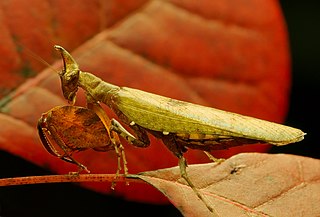
Hestiasula is a genus of Asian praying mantids in the subfamily Oxypilinae of the family Hymenopodidae.

Odontomantis is a genus of mantids in the family Hymenopodidae; species can be found in tropical Asia.
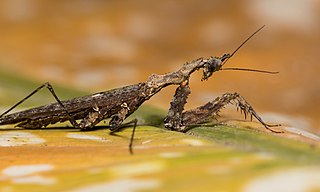
Haania is the type genus of Asian praying mantids in the new (2019) family Haaniidae. They are recorded from: southern China (Hainan), Indo-China and the Philippines.
Epaphroditidae is a family of the Mantodea, containing species found in Africa and the Caribbean. Before 2015, it had been placed as the subfamily Epaphroditinae, in the Hymenopodidae, but is now excluded.
Phyllothelys is an Asian genus of praying mantids in the family Hymenopodidae: subfamily Phyllothelyinae.

Leptomantella is a genus of praying mantids and typical of the new (2019) family Leptomantellidae. Species have been recorded from Asia.

The Haaniidae are a new (2019) family of praying mantids, based on the type genus Haania. The first use of "Haaniidae" was by Giglio-Tos and it was revived as part of a major revision of mantid taxonomy; genera in the subfamily Haaniinae havie been moved here from the family Thespidae.

The Hierodulinae are a subfamily of praying mantids, originally used by Brunner von Wattenwyl. It was restored as part of a major revision of mantid taxonomy, and now contains genera previously placed elsewhere in the family Mantidae.
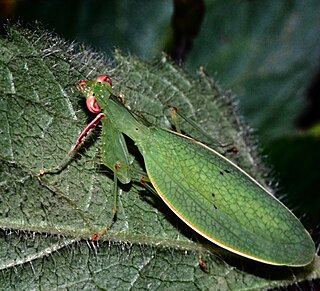
The Nanomantidae are a new (2019) family of praying mantises, based on the type genus Nanomantis. As part of a major revision of mantid taxonomy, genera and tribes have been moved here, substantially replacing the old family Iridopterygidae.

The Gonypetidae are a new (2019) family of praying mantids, based on the type genus Gonypeta. The first use of "Gonypetidae" was by Westwood and it has been revived as part of a major revision of mantid taxonomy; the subfamily Iridopteryginae having been moved here from the obsolete family Iridopterygidae. The Gonypetinae include Asian genera transferred from the obsolete taxa Amelinae and Liturgusidae.
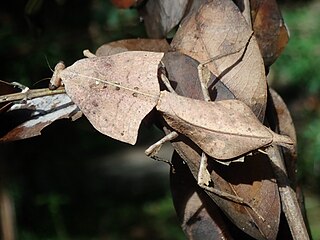
The Deroplatyidae are a new (2019) family of praying mantises, based on the type genus Deroplatys. As part of a major revision of mantis taxonomy, the subfamily Deroplatyinae has been moved here from the previously-structured family Mantidae.
Dactylopterygidae is a family of praying mantises, based on the type genus Dactylopteryx. The first use of "Dactylopterygidae" was by Giglio-Tos and it has recently (2019) been revived as part of a major revision of mantis taxonomy; three genera have been separated from others in the subfamily Liturgusinae and moved here from the family Liturgusidae.
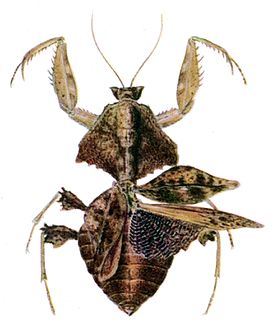
The Majangidae are a revived (2019) family of praying mantids from Madagascar.
The Chroicopteridae are a new (2019) family of praying mantids, based on the type genus Chroicoptera. The name is derived from first use, for subfamily Chroicopterinae, by Giglio-Tos and it has been revived as part of a major revision of mantid taxonomy. Some genera have also been moved here from the tribe Rivetinini, with others placed elsewhere including the subfamily Miomantinae.
Ephestiasula is a genus of praying mantises belonging to the family Hymenopodidae. The species of this genus are found in India.
Catestiasula is a genus of praying mantises belonging to the family Hymenopodidae.











